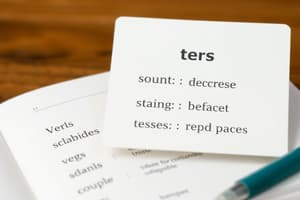Podcast
Questions and Answers
What is the primary function of a verb in a sentence?
What is the primary function of a verb in a sentence?
- To connect the subject to its complement
- To provide additional information about the sentence
- To convey the subject's actions, events, or state of being (correct)
- To express a condition or a state of being
Which of the following verbs is an example of a physical action verb?
Which of the following verbs is an example of a physical action verb?
- feel
- be
- think
- run (correct)
What is the key difference between an action verb and a linking verb?
What is the key difference between an action verb and a linking verb?
- Action verbs express a condition, while linking verbs convey an action
- Action verbs are used in singular sentences, while linking verbs are used in plural sentences
- Action verbs are used in simple sentences, while linking verbs are used in compound sentences
- Action verbs convey an action, while linking verbs express a condition (correct)
Which of the following sentences contains a linking verb?
Which of the following sentences contains a linking verb?
What is the term for a verb that helps the main verb to express its tense, mood, or voice?
What is the term for a verb that helps the main verb to express its tense, mood, or voice?
What is the primary function of auxiliary verbs?
What is the primary function of auxiliary verbs?
Which of the following is an example of a sentence with three helping verbs?
Which of the following is an example of a sentence with three helping verbs?
What is the term for verbs that connect to the main verb in a sentence?
What is the term for verbs that connect to the main verb in a sentence?
What should you look out for when you see an '-ing verb' in a sentence?
What should you look out for when you see an '-ing verb' in a sentence?
What is the function of the word 'not' in a sentence with a helping verb?
What is the function of the word 'not' in a sentence with a helping verb?
Flashcards are hidden until you start studying
Study Notes
Types of Verbs
- Verbs can be classified into four categories: Action Verbs, Linking Verbs, Auxiliary/Helping Verbs, and Primary Verbs
- Action Verbs denote an action, can be physical (e.g. feeds, runs) or mental (e.g. likes, thinks)
- Examples of Action Verbs: danced, wrote, worked, filled, tasted, walked, arrived, drafted
- Linking Verbs connect the subject of a sentence to its complement, expressing a condition or state of being
- Examples of Linking Verbs: is, am, seems, tastes
Auxiliary/Helping Verbs
- Auxiliary/Helping Verbs help the main verb express action or precise shades of meaning
- Can be used in combination with the main verb to form a verb phrase
- Examples of Primary Auxiliary Verbs: be, have, do
- Examples of Modal Auxiliary Verbs: can, could, may, might, shall, should, will, would
- Auxiliary/Helping Verbs can be used to express different tenses and aspects, such as present, past, and future
- Not every sentence has an Auxiliary/Helping Verb, but when you see an '-ing verb', be on the lookout for a helping verb along with it
- A sentence can contain up to three helping verbs to the main verb, such as "must have been"
Studying That Suits You
Use AI to generate personalized quizzes and flashcards to suit your learning preferences.




